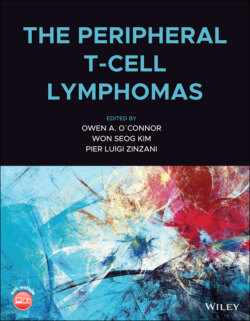Читать книгу The Peripheral T-Cell Lymphomas - Группа авторов - Страница 60
DNA Methyltransferase Inhibitors
ОглавлениеAs discussed previously, a host of mutations in genes governing DNA methylation suggests that another class of drugs targeting the epigenome, namely the HMA, can play a crucial role in the development of novel therapeutic strategies. The DNMT inhibitors (or HMA as they are commonly termed) including azacitidine and decitabine, for example, represent the first class of epigenetic modulating drugs to be approved by the Federal Drug Administration (FDA). These drugs are pyrimidine nucleoside analogues of cytosine that have the ability to become incorporated into DNA and form covalent bonds between the 5‐azacytosine ring and the DNMT enzyme, thus causing irreversible DNMT inactivation [92]. Logically, DNMT inhibitors would seem likely to function by reversing the silencing of tumor‐suppressor genes, although the precise mechanism of action of DNMT inhibitors is poorly understood. While this phenotype of increased CpG methylation is a well‐established and a recurrent pathological feature across many types of cancer, mutations in important genes governing DNA methylation leading to a hypermethylated phenotype in PTCL suggest that drugs such as 5‐azacitidine and decitabine can be an important component of future combination regimens in select subtypes of these diseases. In ATLL, an in vitro study revealed that 5‐azacitidine inhibits growth of tumor cells by demethylation of the promotor region of a tumor suppressor and inhibition of the cyclin dependent kinase, p16INK4a [93]. In a study published by Delarue et al., injectable 5‐azacitidine, as a single agent, produced an overall response rate of 53% in 19 patients with relapsed or refractory PTCL [72]. Of the 19 patients in this study, 12 had a diagnosis of AITL and, in this patient population, the overall response rate was as high as 75% (9/12), with a complete response rate of 50% [94]. Interestingly, all the patients with AITL harbored TET2 mutations, with 58% harboring two mutations. In addition, 33% patients had DNMT3A mutations, 41% had RHOA mutations, with most of them having pG17V substitution. The impact of the mutation status on response was not evaluable as all the patients had the mutation [72]. Interesting, a recent report demonstrated a durable response to azacitidine in the absence of any identifiable mutations [95].
Table 3.2 Single agents targeting the T‐cell lymphoma epigenome.
| Drug | Class/Mechanism | Disease | Patients (n) | ORR (%) | CR (%) | Median PFS (months) | Median DOR (months) | Refs. |
|---|---|---|---|---|---|---|---|---|
| Romidepsin | Bicyclic pan‐HDACi | PTCL/CTCL | 130 | 25 | 15 | 4 | 28 | [88] |
| Vorinostat | Hydroxamic acid‐based pan‐HDACi | CTCL | 74 | 30 | 1.4 | nr | > 6.2 | [89] |
| Chidamide | Hydroxamic acid‐based pan‐HDACi | PTCL | 79 | 28 | 14 | 2.1 | 9.9 | [90] |
| Belinostat | Hydroxamic acid‐based pan‐HDACi | PTCL | 120 | 26 | 11 | 1.6 | 13.6 | [70] |
| Pralatrexate | Folate antagonist, modulation of genes involved with DNA methylation | PTCL/CTCL | 109 | 29 | 11 | 3.5 | 12.1 | [91] |
| Azacitidine | Hypomethylation agent | PTCL | 19 | 53 | 26 | nr | nr | [72] |
CR, complete response; CTCL, cutaneous T‐cell lymphoma; DOR, duration of response; HDACi, histone deacetylase inhibitor; nr, not reported; ORR, overall response rate; PFS, progression‐free survival; PTCL, peripheral T‐cell lymphoma.
